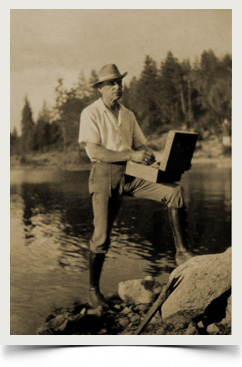A Chronology of Tilden Daken’s Life
From Illinois to the Gold Country (1876—1902). Samuel Tilden Daken was born in Bunker Hill, Illinois, on June 14, 1876. His family moved to Sacramento, California, when he was three years old. In his youth he mined in the Sierra foothills with his father. As a child, he developed an interest in nature, classical music, and painting in the backwoods. By his teens he was painting frescoes in limestone in the homes of San Francisco’s high society. In 1901, in the rail yard station in Reno, Tilden met a young writer named Jack London, and together they rode the brake beams of a freight car over Donner Pass to Oakland.
Early San Francisco years (1903—1906). Tilden married dressmaker Mary Elizabeth Duplissea in San Francisco in 1903. In 1906, the couple’s Mission Street home and the artist’s studio on Van Ness Avenue were destroyed in the earthquake and fire. In the aftermath, the Dakens, and thousands of other refugees, lived in “Tent City” in Golden Gate Park.
Sonoma County years (1906—1912). Following the earthquake, the Dakens moved 50 miles north to the town of Glen Ellen in Sonoma County, where their daughters, Edith and Sydney, were born in 1907 and 1908. Tilden resumed his friendship with Jack London, gained recognition as the “Painter of the Valley of the Moon,” and developed a passion for painting in the California redwoods. In early 1909, the family moved to Santa Rosa, a Sonoma County town. Tilden opened two studios, was head of the art department at Ursuline College, and spent four years funding raising for the “Daken Art Institute,” his dream project that never came to fruition.
Return to San Francisco (1912—1913). After six years in Sonoma County, the Daken family returned to San Francisco in early 1912. Tilden opened a studio on Gough Street and held exhibitions.
Mexican Revolution (1913—1914). In 1913, Tilden left his family and moved to Mazatlan. While planning two south-of-the-border exhibitions for the 1915 Panama-Pacific International Exposition, he was wounded and held a prisoner of war under Carranza’s rule. He escaped, or was released, and returned to San Francisco in late 1914.
Panama-Pacific International Exposition (1915). In 1915, Tilden joined with hundreds of other artists at the Panama-Pacific International Exposition, honoring the opening of the Panama Canal and the rebirth of San Francisco. He gained international recognition with his “South of the Border” collection and the “Mexican Exhibit” in the Palace of Agriculture, featuring his massive mural El Rosario River of the West Coast of Mexico.
The Submarine Studio diving bell (1915—1926). In late 1915, Tilden traveled to the Hawaiian Islands where he experimented with painting underwater ocean scenes. After near-death experiences swimming with sharks, he built a custom-designed diving bell, the “Submarine Studio.” He is said to have painted 300 underwater scenes in his diving bell, and he exhibited them coast to coast. In 1926, he published “In the Grip of an Octopus,” a short story about his experiences with sharks and a giant octopus. His Short Stories
The Northern California Alps and the winter of 1922. Tilden battled deep snow and frigid temperatures while painting for months in the Sierra Nevada and later exhibited a series of 100 works known as the “Northern California Alps” collection — arguably the artist’s greatest legacy. In 1928, he published “Experiences in the Rugged West” chronicling an eight-week journey into the high country. His Short Stories
Hollywood years (1923—1925). In early 1923, Tilden moved to Hollywood, hobnobbed with celebrities, and painted portraits of silent film stars. A classical music aficionado, he displayed synethesia, a neurological condition of the senses he had developed in his childhood; he painted before audiences to orchestral music in the red palette, known as his “Key of Red” era. While living in Hollywood, he set sail for New Guinea with his anthropologist friend to study and paint the headhunters.
Marin County years (1925—1930). Tilden returned to Northern California, settled in Marin County, and built a home in the Cascade Canyon in Mill Valley. A photograph of the enchanting arts and crafts home is featured on Wikipedia’s Mill Valley history page. Having divorced his first wife in 1918, he remarried during his Mill Valley years. He resumed teaching art classes and painted hundreds of scenes of Mount Tamalpais, Muir Woods, Tiburon, and Point Reyes.
The Great Depression, a cross-country tour, and return to the Gold Country (1930—1935). In early 1930, Tilden and his second wife left Mill Valley and embarked on a cross-country tour. The artist exhibited in Chicago, Cincinnati, and New York City, and lived in Greenwich Village for a year. In 1932, the Dakens spent nine months in the Bootjack mining camp near Yosemite. In 1933, they settled in Georgetown, the historic Gold Rush town in El Dorado County where Tilden had mined in his youth. In early 1935, Tilden was diagnosed with cancer, likely from exposure to lead paint and distillates from the age of six. He died on April 24, 1935, and is buried in the Georgetown Pioneer Cemetery. His works have been exhibited often since his death. Exhibitions

